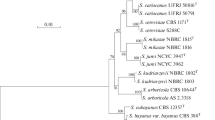Summary
Contour-clamped homogeneous electric field gel electrophoresis was used to establish karyotypes for fungi of Aspergillus Section Flavi. Under identical electrophoretic conditions, five to eight chromosomal bands were separated in Aspergillus flavus isolates and five to seven chromosomal bands in A. parasiticus isolates. Each distinct chromosomal band contained one or more chromosomes. Other members of Aspergillus Section Flavi (A. oryzae, A. sojae, and A. tamarii) had similar karyotypes to those of A. flavus and A. parasiticus. A related species, A. versicolor, showed six chromosomal bands. With the exception of small chromosomes present in some isolates, the estimated sizes of chromosomes for all six species range from approximately 3.0 to ≥7.0 Mb. It is likely that all isolates of these species contain the same number of large (>3 Mb) chromosomes; however, not all of the chromosomal bands could be resolved into separate chromosomes for each isolate due to chromosome length polymorphisms. This variability, observed in A. flavus and A. parasiticus, generated unique chromosomal band patterns within these species. The total genome sizes of these fungi were at least as large as those reported for A. nidulans and A. niger (31–38.5 Mb). Conserved genes were mapped to analogous chromosomes of A. flavus and A. parasiticus by gene hybridization.
Similar content being viewed by others
References
Adye J, Mateles RI (1964) Biochim Biophys Acta 86: 418–420
Bradshaw RE, Bennett JW, Peberdy JF (1983) J Gen Microbiol 129: 2117–2123
Bressac B, Kew M, Wands J, Ozturk M (1991) Nature 350: 429–431
Brody H, Carbon J (1989) Proc Natl Acad Sci USA 86: 6260–6263
Debets AJM, Holub EF, Swart K, van den Broek HWJ, Bos CJ (1990) Mol Gen Genet 224: 264–268
Hajjar JD, Bennett JW, Bhatnagar D, Bahu R (1989) Mycol Res 94: 548–551
Horng JS, Linz JE, Pestka JJ (1989) Appl Environ Microbiol 55: 2561–2568
Horng JS, Chang PK, Pestka JJ, Linz JE (1990) Mol Gen Genet 224: 294–296
Hsu IC, Metcalf RA, Sun T, Welsh JA, Wand NJ, Harris CC (1991) Nature 350: 427–428
Jelinek CF, Pohland AE, Wood GE (1989) J Assoc Anal Chem 22: 223–2340
Jones RN, Rees H (1982) B chromosomes. Academic Press, London
Kinscherf TC, Leong SA (1988) Chromosoma 96: 427–433
Klich MA, Pitt JI (1988) Trans Br Mycol Soc 91: 99–108
Leaich LL, Papa KE (1974) Mycopath Mycol Appl 52: 223–229
Lennox JE, Davis CK (1983) Exper Mycol 7: 192–195
Masel A, Braithwaite K, Irwin J, Manners J (1990) Curr Genet 18: 81–86
McCluskey K, Mills D (1990) Mol Plant-Microbe Interact 6: 366–373
Miao VPW, Matthews DE, VanEtten HD (1991) Mol Gen Genet 226: 214–223
Moody SF, Tyler BM (1990a) Appl Environ Microbiol 56: 2441–2452
Moody SF, Tyler BM (1990b) Appl Environ Microbiol 56: 2453–2451
Orbach MJ, Vollrath D, Davis RW, Yanofsky C (1988) Mol Cell Biol 8: 1469–1473
Osiewacz HD, Clairmont A, Huth M (1990) Curr Genet 18: 481–483
Papa KE (1976) Mycologia 68: 159–164
Papa KE (1977) Mycologia 69: 1185–1190
Papa KE (1978) Mycologia 70: 766–773
Papa KE (1979) Genet Res 34: 1–9
Papa KE (1982) J Gen Microbiol 128: 1345–1348
Papa KE (1984) Can J Microbiol 30: 68–73
Rabie CJ, Lubben A, Steyn M (1976) Appl Environ Microbiol 32: 206–208
Raper KB, Fennell DI (1965) In: Raper KB, Fennell DI (eds) The Genus Aspergillus. The Williams and Wilkins Co., Baltimore, pp
Sambrook J, Fritsch EF, Maniatis T (1989) Molecular Cloning: a Laboratory Manual. Cold Spring Harbor Laboratory, Cold Spring Harbor, New York
Seip ER, Woloshuk CP, Payne GA, Curtis SE (1990) Appl Environ Microbiol 56: 3686–3692
Skory CD, Horng JS, Pestka JJ, Linz JE (1990) Appl Environ Microbiol 56: 3315–3320
Woloshuk CP, Seip ER, Payne GA, Adkins CR (1989) Appl Environ Microbiol 55: 86–90
Author information
Authors and Affiliations
Additional information
Communicated by H. Bertrand
Rights and permissions
About this article
Cite this article
Keller, N.P., Cleveland, T.E. & Bhatnagar, D. Variable electrophoretic karyotypes of members of Aspergillus Section Flavi . Curr Genet 21, 371–375 (1992). https://doi.org/10.1007/BF00351697
Received:
Accepted:
Issue Date:
DOI: https://doi.org/10.1007/BF00351697




